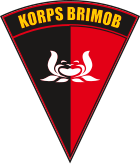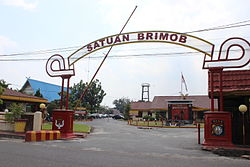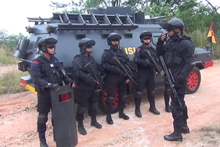Mobile Brigade Corps
| Mobile Brigade Corps | |
|---|---|
| Korps Brigade Mobil (Indonesian) | |
 Emblem of the Mobile Brigade Corps | |
| Active | 14 November 1945 |
| Country | Indonesia |
| Agency | Indonesian National Police |
| Type | Police tactical unit |
| Headquarters | Mako Brimob, Cimanggis, Depok, West Java |
| Motto | Jiwa Ragaku Demi Kemanusiaan (My life and soul is for the sake of humanity) Sekali Tampil Harus Berhasil (Once we perform we must succeed) |
| Common name | Brimob |
| Structure | |
| Officers | 34,250[1] (2008) |
| Commanders | |
| Current commander | Pol. Com. Gen. Imam Widodo[2] |
| Notables | |
| Significant operation(s) |
|
| Anniversaries |
|
| Website | |
| korbrimob | |
The Mobile Brigade Corps (
The Mobile Brigade Corps consists of 2 (two) branches, namely Gegana and Pelopor. Gegana is tasked with carrying out more specific special police operations tasks such as: Bomb Disposal, CBR Handling (Chemistry, Biology, and Radioactivity), Anti-Terror (Counter Terrorism), and Intelligence. Meanwhile, the Pelopor are tasked with carrying out broader and paramilitary special police operations tasks, such as: Riot control, Search and Rescue (SAR), security of vital installations, and guerrilla operations. The Mobile Brigade Corps are capable of other operations that support the performance of general police units. The Brimob Corps is classified as a Police Tactical Unit (PTU) and is operationally a Police Special Weapons and Tactics (SWAT) unit (including Densus 88 and Gegana Brimob). Each regional police (Polda) in Indonesia has its own Mobile Brigade unit.
History
Formed in late 1945 as a special police corps named Pasukan Polisi Istimewa (Special Police Troops) with the task of disarming remnants of the
On 14 November 1946, Prime Minister Sutan Sjahrir reorganised the Polisi Istimewa into the Mobile Brigade (Mobrig). This day is celebrated as the anniversary of this Blue Beret Corps. This Corps was reconstituted to suppress military and police conflicts and even coups d'etat.
On 1 December 1947, Mobrig was militarized and later deployed in various conflicts and confrontations like the PKI rebellion in Madiun, the Darul Islam rebellion (1947), the APRA coup d'état and proclamation of the Republic of South Maluku (1950), the PRRI rebellion (1953), and the Permesta (1958).
As of 14 November 1961, the Mobrig changed its name to Korps Brigade Mobil (Brimob), and its troops took part in the
The Mobile Brigade, which began forming in late 1946 and was used during the anti-Dutch Revolution, started sending students for US Army SF training on Okinawa in January 1959. In April 1960 a second contingent arrived for two months of Ranger training. By the mid-1960s the three-battalion Mobile Brigade, commonly known as Brimob, had been converted into an elite shock force. A Brimob airborne training centre was established in Bandung. Following the 1965 coup attempt, one Brimob battalion was used during anti-Communist operations in West Kalimantan. In December 1975 a Brimob battalion was used during the East Timor operation. During the late 1970s, Brimob assumed VIP security and urban anti-terrorist duties. In 1989, Brimob still contained airborne-qualified elements. Pelopor ('Ranger') and airborne training takes place in Bandung and at a training camp outside Jakarta.[3] Historically, Brimob wore the Indonesian spot camouflage pattern during the early 1960s as their uniform.[3]
In 1981, the Mobile Brigade spawned a new unit called the "Jihandak" (Penjinak Bahan Peledak), an
Task

The Implementation and mobilization of the Brimob Corps is to cope with high-level interruption of society mainly: mass riots, organized crime armed with fire, search and rescue, explosives, chemicals, biological and radioactive threats along with other police operational implementing elements in order to realize legal order and peace of society throughout juridical of Indonesia and other tasks assigned to the corps.
Qualifications
The Pelopor qualifications, which are the basic capabilities of every Brimob member, are the following basic skills:
- Ability to navigate with map and compass
- Intelligence
- Anti-terror (counter-terrorism)
- Riot control
- Guerrilla war, Close / Urban wartactics
- Bomb disposal
- Handle high intensity crimes where the use of firearms is present
- Search and rescue
- Surveillance, disguise and prosecution.
- Other individual and unit capabilities.[4]
Function

The function of the Police's Mobile Brigade Corps as the Polri's Principal Operating Unit which has specific capabilities (Riot control, Combat Countermeasures, Mobile Detective, Counter-terrorism, Bomb Disposal, and Search and Rescue) in the framework of High-level domestic security and community-supported search and rescue personnel who are well trained and have solid leadership, equipment and supplies with modern technology.
Role
The role of Brimob is together with other police functions is to act against high-level criminals, mainly mass riots, organized crime of firearms, bombs, chemicals, biology and radio active threats in order to realize the legal order and peace of society in all juridical areas of Indonesia. Roles undertaken include:
- Role to help other police functions,
- Role to complement in territorial police operations carried out in conjunction with other police functions,
- Role to protect members of other police units as well civilianswho are under threat,
- Role to strengthen other police functions in the implementation of regional operational tasks,
- Serve to replace and handle territorial police duties if the situation or task objective has already led to a high-grade crime.[5]
Organisation


In 1992 the Mobile Brigade was essentially a paramilitary organisation trained and organised along military lines. It had a strength of about 12,000. The brigade was used primarily as an elite unit for emergencies and supporting police operations as a rapid response unit. The unit was mainly deployed for domestic security and defense operations, but now has gained and achieved many specialties in the scope of policing duties such as implementing SWAT operations, Search and Rescue operations, Riot control and
Since the May 1998 upheaval, PHH (Pasukan Anti Huru-Hara, Anti Riot Unit) have received special anti-riot training. Elements of the unit are cross trained for
The Chief of the Indonesian National Police, known as KAPOLRI, has the highest command in each police operation including BRIMOB, orders are delivered by the police chief and then executed by his Operational Assistant Agent with then further notification to the Corps Commandant and then to the concerned regional commanders.
National Level Units
- Corps HQ and HQ Services
- Brimob Corps Training School
- Gegana Battalion
- HHC
- Pelopor Brigade
- Brigade HQ and HQ Company
- I (1st) Pelopor Regiment
- II (2nd) Pelopor Regiment
- III (3rd) Pelopor Regiment
- IV (4th) Pelopor Regiment
- Intelligence Unit
- Training Command
Pelopor

Pelopor (lit."Pioneer") is the main reaction force of the Mobile Brigade Corps, it acts as a troop formation and has the roles of mainly
- I' Pelopor Regiment
- II Pelopor Regiment
- III Pelopor Regiment
- IV Pelopor Regiment
In a historical view, this unit was called as "Brimob Rangers" during the Post Independence era. In 1959, during its first formation, Brimob Rangers troops conducted a test mission in the area of Cibeber, Ciawi and Cikatomas which borders Tasikmalaya-Garut in West Java. It was the baptism of fire of the Rangers, in which the newly acquired skills of guerrilla warfare and counter-insurgency operations were applied against remnants of Darul Islam in these communities. The actions against the Islamic Army of Indonesia (TII) units in the province weakened the DI even further, leading the total collapse of the local DI provincial chapter in 1962, ending a decade-long war of violence there.
The official first forward deployment of the Brimob Rangers was the Fourth Military Operations Movement in South Sumatra, West Sumatra and North Sumatra (in response to the Permesta rebellion of 1958). It was the Brimob Rangers troops became part of the Bangka Belitung Infantry Battalion led by Lieutenant Colonel (Inf) Dani Effendi. Rangers were tasked to capture the remains of the PRRI prison in Sumatra's forests led by Major Malik, which was then under rebel hands.
In 1961, under the express orders of then Chief of Police General Soekarno Djoyonegoro, Brimob Rangers troops were officially renamed Pelopor Troops of the Mobile Brigade. This is in accordance with the wishes of President
Pelopor Troops play a role as a troop formation unit and is still active in the Brimob's operational system. Aside from the national regiments, each Police region has a Pelopor regiment of two to four battalions.
Gegana

Gegana is a special branch detachment within the Brimob corps which have special abilities mainly in
- Intelligence Detachment
- Bomb Disposal Detachment
- Anti-TerrorDetachment
- Anti-Anarchist Detachment
- CBR (Chemical, biological and radiological) Detachment
This unit was formed in 1976 as a detachment. At first, it was meant to deal with aircraft hijacking. Later in 1995, with the expansion of Brimob, the Gegana Detachment was expanded to become the 2nd BRIMOB Regiment. However, there are a select few specialists who are very skilled in these specialties. Gegana does not have battalions or companies. The regiment is broken down into several detachments. Within each detachment they are split into sub-detachments (sub-den), and within each sub-den they are further sub-divided into several units. Each unit usually consists of 10 personnel. One sub-den consists of 40 personnel, and one detachment consists of about 280 personnel.
One operation is usually assigned to one unit. Therefore, from the 10 people in that unit, six are required to have special skills: two for EOD (Explosives and Ordnance Disposal), two for search and rescue operations, and two for counter-terrorist operations. In any operation, two experts are designated Operators One and Two while the rest of the unit members become the Support Team.
For example, in counter-terrorism operations, the designated Operators must have sharp-shooting skills, ability to negotiate, and be an expert in storm-and-arrest procedures. These skills and operations are not meant to be lethal because the main goal of every Gegana operation is to arrest suspects and bring them to the court. Unless there is a situation that is compromised, Gegana avoids the use of lethal force.
In Search and Rescue operations, the personnel are required to have the basic capabilities of diving, rappelling, shooting, and first aid. In anti-bomb operation, the Operators have to be the expert in their respective fields. Each Gegana personnel has been introduced to various types of bombs in general, including the risks of handling them. There are specific procedures for handling each bomb, including the required timing.
Currently, Gegana's national battalion has three
Gegana battalions or companies are present in each provincial police unit.
Unit composition
Alongside the national units, regional formations of the Mobile Brigade are present in all 38 Regional Police Forces (Polda) in Indonesia which represent a province. In each BRIMOB unit of a Police HQ in a province (Polda), there are about several detachments of MBC Pelopor units (organized into a regiment) and usually 1 - 2 detachment of Gegana (small battalions or companies).
A Brimob unit of a regional police headquarters consists of the following:
- Regional Mobile Brigade HQ Section (Si-yanma)
- Planning and Administration Section (Subbagrenmin)
- Intelligence Section (Si-intel)
- Operational Section (Si-ops)
- Provost (Internal affairs) Section (Si-provos)
- Communications Technology Section (Si-tekkom)
- Medical and Fitness Section (Si-kesjas)
- Search and Rescue(SAR) Unit
- Pelopor Regiment composed of:
- Regional Pelopor Regimental HQ
- A Detachment (Den-A)
- B Detachment (Den-B)
- C Detachment (Den-C)
- D Detachment (Den-D) (large departments only)
- Support units
- Gegana Detachment (Den Gegana)[7]
- Detachment HQ
- 1-3 Subdetachments/Platoons
For some regional police headquarters, Pelopor detachments only consists up-to "C" Detachments only (3 battalions each). But for bigger regional police HQs such as the
In the 2020s, the regional organization was amended with regional divisional commands (Pasukan Brigade Mobil), under which each provincial brigade reports directly. The BRIMOB divisions are led by Police Brigadier Generals.
- Personnel
-
Gegana
-
Pelopor
-
Search and Rescue(SAR) unit
Controversies
2020s
In the
Gallery
-
Gegana operators
-
Brimob Pindad Komodo tactical vehicle
-
A Brimob Riot water cannon vehicle
-
Brimob M8 Greyhound armored car during a parade c. 1990s
-
A Brimob officer and a Brimob constable during the 2016 Jakarta attacks
-
Brimob personnel during Riot control
-
A Brimob personnel with a Pindad SS1 rifle guarding the Jakarta Cathedral.
See also
- counter-terrorismsquad
References
- ^ a b International Business Publications USA, US-Indonesia Diplomatic and Political Relations Handbook, 2008
- ^ Nulloh Ibrohim, Amien. "Komjen Imam Widodo Resmi Jabat Komandan Brimob Polri". sindonews.
- ^ a b Kenneth Conboy, Simon McCouaig South-East Asian Special Forces, D3 Lieutenant, BRIMOB, 1983. Osprey, 1991
- ^ Motto Brimob, Brimob Polri site, 24 August 2007, retrieved 6 May 2017
- ^ Tugas Pokok, Fungsi dan Peranan Brimob, Bangka Belitung Regional Police Brimob Unit, archived from the original on 6 April 2017, retrieved 6 May 2017
- ^ Brimob Pelopor Pasukan Elit Polri, Aulia Awaluddin, 30 July 2015, retrieved 6 May 2017
- ^ Sat Brimob, Jambi Regional Police (Polda Jambi), 13 July 2015, retrieved 6 May 2017
- ^ "Stadium tragedy exposes Indonesia's troubled soccer history". Associated Press. 3 October 2022. Archived from the original on 3 October 2022. Retrieved 4 October 2022.
- ^ Febrianto, Vicki; S, Resinta (24 October 2022). Haryati, Sri (ed.). "Death count in Kanjuruhan tragedy climbs to 135". ANTARA News. Retrieved 26 October 2022.
- ^ "Indonesia: 125 killed after 'riots' at football match". Deutsche Welle. 2 October 2022. Retrieved 5 April 2023.
- ^ "Former Policeman Found Guilty of Kanjuruhan Football Mass Stampede". Tempo. 16 March 2023. Retrieved 5 March 2023.
- ^ Wee, Sui-Lee; Sijabat, Dera Menra (16 March 2023). "Two Acquittals and One 18-Month Sentence in Indonesia Soccer Disaster". The New York Times. Retrieved 17 March 2023.
- ^ Ancely, Natasha (16 February 2023). "Sidang Kanjuruhan Diwarnai Aksi Intimidasi dari Anggota Brimob pada JPU". Kompas (in Indonesian).










